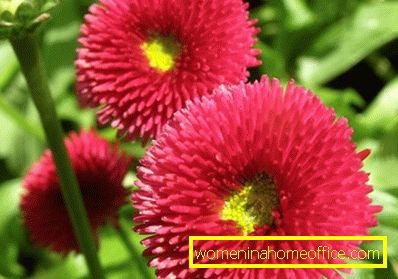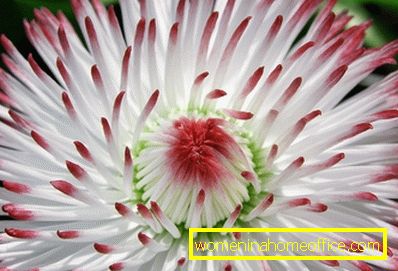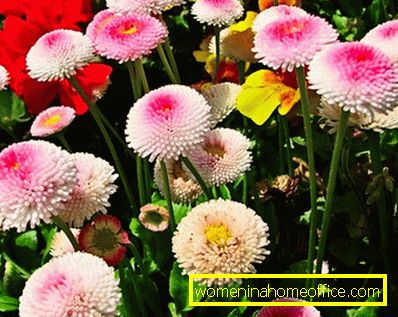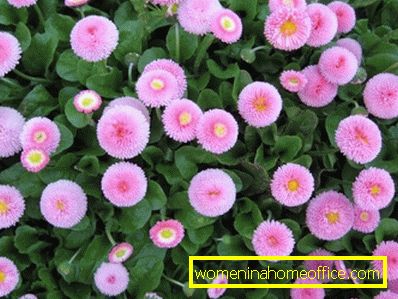Daisies
Daisies are beautiful flowers that are actively used in landscape design. Today, there are many varieties of these lovely perennial and annual plants. Daisies can be grown in the open field, and at home in a pot.
Daisy: popular flower varieties with photos
The plants have egg-shaped leaves of a bright green color. At the root, they unite in a socket, which also unite and form small fluffy bushes with inflorescences. Flowers can be a lot. They come in the form of baskets with several rows of petals, there are also varieties with very fluffy terry buds.
Daisy bushes reach up to 20 cm in height. Plants bloom profusely and for a long time, flowering begins in springtime. In the hottest month of summer, July, it stops, and in August it resumes again. The flowerbed design combines daisies with daffodils and tulips. The most popular varieties of daisies:
- "Pomponett" - a plant with medium-sized flowers that look like buttons. The average diameter of the buds is 2 cm.

- "Robella" has luxurious flowers of coral color, looks very nice in flowerbeds and decor.

- "Habaner" is distinguished by its rather large flowers with double shades, on average, the diameter of 1 bud can be 6 cm.

Perennial Daisies: Cultivation
Soil flowers like with good drainage, cultivated. It is preferable to plant in loams that perfectly hold water. Before planting in open ground, it is necessary to prepare the soil in advance. In autumn, it is desirable to fertilize the land with humus and manure. This food will be enough for a plant for a long time.
Daisies love sunlight, they should be planted in well-lit places. In shady terrain, they may wither. The penumbra is ideal for plants, in such conditions daisies will bloom very luxuriantly and beautifully, and their leaves will be tender. Flowers grown in partial shade will be higher, and growing in sunlight - lower, they will have fewer buds.
Daisy flowers: planting and care in the open field

The roots of daisies are shallow in the ground, which is why plants require good and regular watering. If the flowers grow on dry soil, they will have small inflorescences that have lost their fluffiness. It is recommended after each watering to loosen the soil around the plants so that oxygen can penetrate into it.
It will also be useful to do mulching, that is, sprinkle the surface of the soil with leaves, sawdust, and humus. This will help retain moisture for a longer time. This technique also prevents the roots from sticking out, which often happens when the soil dries out.
Daisies need a good feeding, fertilizer and humus recommended at least 2 times in 1 season. As soon as the cold recedes, and the soil begins to thaw, you need to make urea. It is sprinkled on areas with planted flowers in the required proportions. This top dressing is important for plants, because in early spring, daisies are characterized by active growth, which requires a large amount of nutrients and minerals.
The next fertilization is done at the very beginning of summer, when young shoots start growing from plants. Feed up with nitroammophos. In order to bloom lasted longer, it is necessary to remove the faded baskets. At the end of autumn there is no need to cut the leaves of the plant and tear buds. Daisies tolerate the winter well, but it is better to cover them with leaves or fir branches.
How Daisies Propagate: Features

There are 3 ways to reproduce colors:
The division of the bushes helps to maintain the characteristics of the variety of daisies. You can divide only the bushes of plants that are at least 2 years old. During this time, the daisies have time to grow, but lose their decorative appearance, so they need to be seated.
In the process of division and planting plants rejuvenate and gain a lot of power for growth and development. It is best to divide the bushes in mid-summer, around July. As a rule, it is at this time that the flowering is somewhat suspended. Bushes need to dig and separate the large rosettes with roots. 1 big bush can give 12 small plants.
Remove the leaves from the separated bushes and cut the roots slightly. Flowers with buds need to be torn off. It is best to plant new specimens in the penumbra and water more often than adult plants. Some flower growers, however, are convinced that division is best done not in summer, but in spring or autumn.
Propagation by cuttings is done in May or at the very beginning of June. This method involves the separation of the side shoots with leaves and planting them in a wet and soft, loose soil. The roots of the cuttings may appear within 2 weeks after disembarkation. Daisies obtained in this way will only bloom next year.
Propagation of daisies by seeds is a convenient and easy way. The stores sell many varieties of these wonderful flowers. Planted in open ground at the end of June. It is not recommended to sow daisies too deep, the seeds should be placed almost on the surface of the site, previously loosened and fertilized. Then you need to sprinkle them with a small layer of loose earth or sand. Daisies will grow in 7-10 days after sowing.
It is very important to do a pick of young bushes. This means that before planting at a permanent place in plants, you need to trim the roots a little. This will allow the root system to branch, the flowers will be stronger and more resistant. Seedlings transplant carried out 2 months after sowing, that is, in August. Observe the distance between the plants not less than 20 cm.
Flowering in such daisies will begin only in the spring of next year. If, however, sow them in the greenhouse at the very beginning of March, then the buds can be obtained already in the first year of life. This method of plant propagation by seeds is used by many flower growers.
Daisies breed and independently. If you do not tear off faded baskets, they will give seeds that will sow the soil around a large bush and will spring in the spring. Such seedlings also need to swoop down and sit down. The only disadvantage of self-seeding is that such daisies may not retain the characteristics of the variety.
Daisy pests and diseases

If you decide to grow daisies in your flowerbed, you need to know about diseases and pests that can threaten plants. In general, they rarely get sick. However, sometimes powdery mildew appears on them - a white coating on the leaves. Also, many growers find gray rot on plants. The causes of such diseases can be the following:
- Too dense planting of daisies, non-compliance with the distance between the bushes. Poor airing sites.
- Excessive addition of fertilizer to the soil.
- Excessive watering, too wet soil.
- A sharp temperature drop, a big difference between daytime and nighttime temperatures.
From powdery mildew, fungicidal agents and Topaz chemical complex help well. The gray rot will be eliminated by such means as "Fundazol", "Skor", and "Euparin". At the same time it is necessary to ensure that the leaves and flowers of the daisy remain dry.
Damage to daisies and some insects. Especially love their caterpillars, butterflies, scoops and slugs. Insecticides will help to remove the caterpillars: "Lepidocide", "Fitoverm", "Bicol", "Aktellik". Metaldehyde works well with slugs.
Daisies will revive and decorate your flowerbed and garden. Plants are hardy and unpretentious, but in order for them to bloom beautifully and densely, you need to follow the rules of care and planting. Also, with the appearance of diseases and pests, urgent measures should be taken.